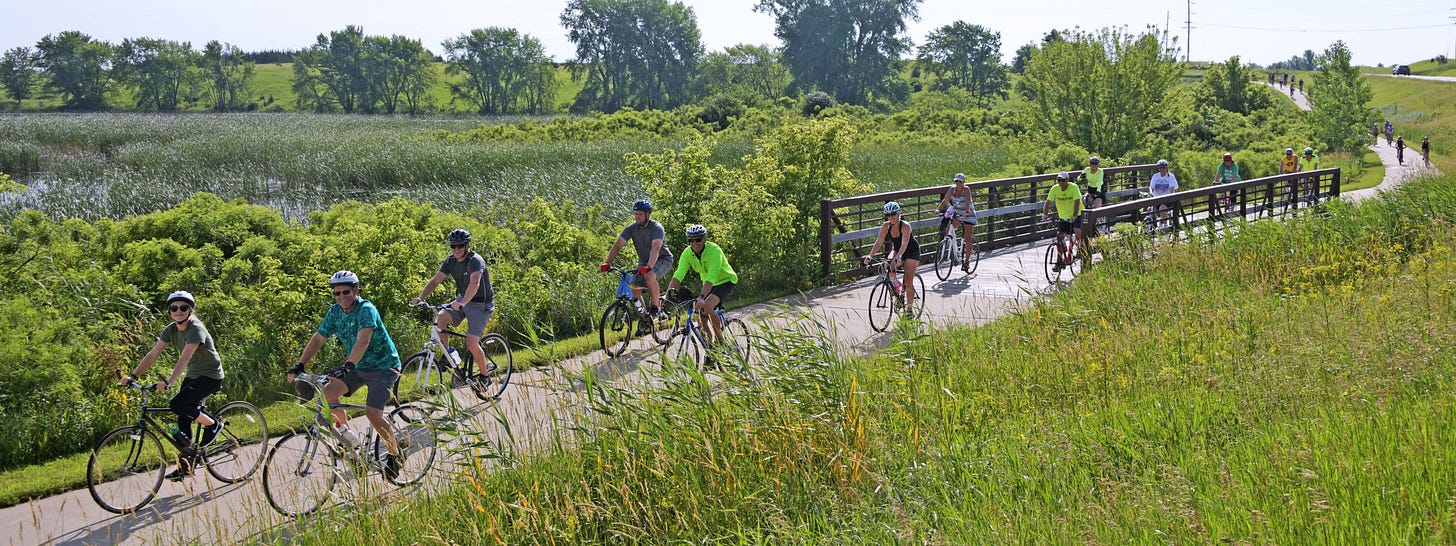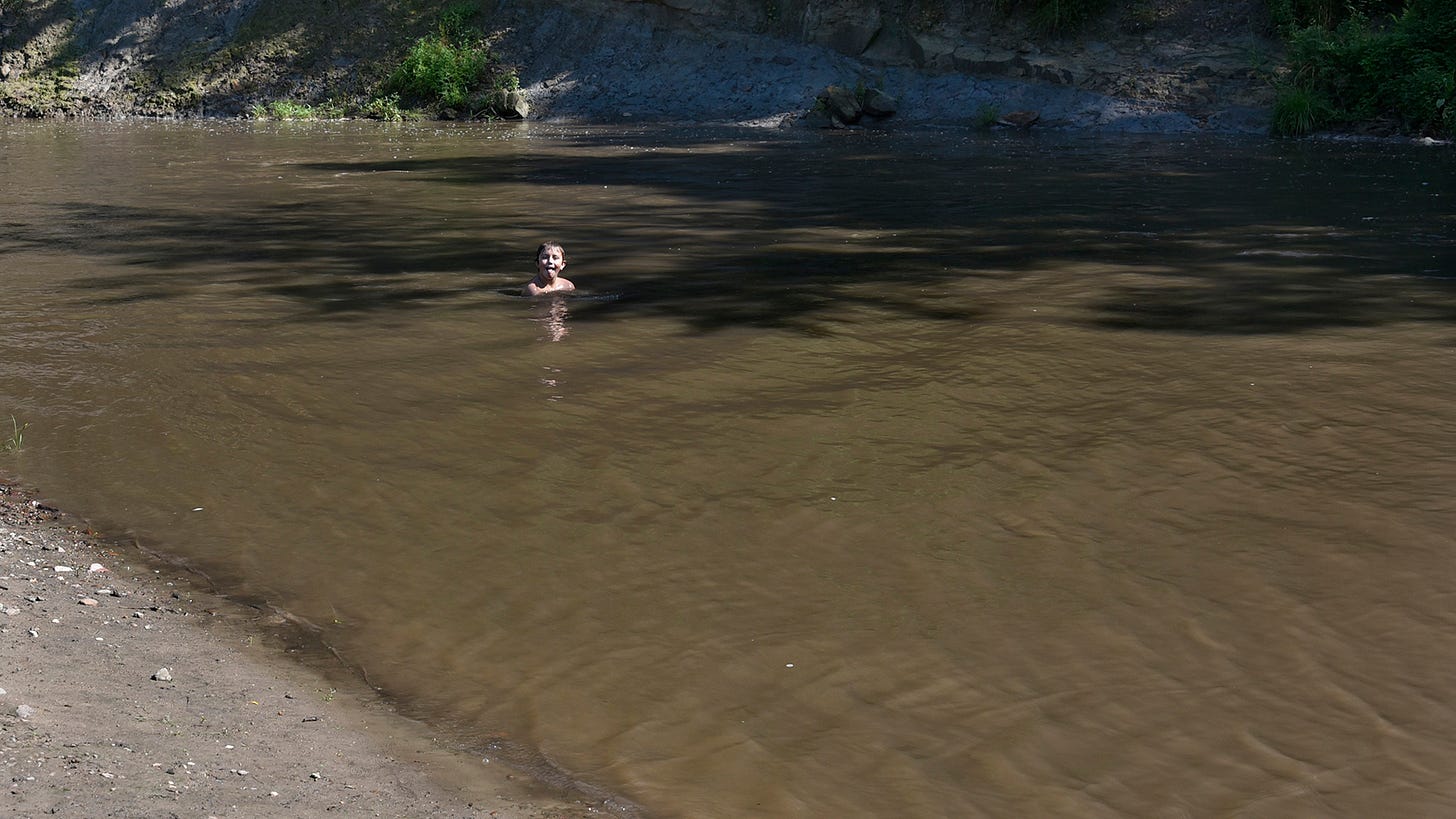Could Iowa be a Recreational Superpower?
RAGBRAI and Okoboji Provide Models for a More Prosperous, Outdoor Iowa

As Chris Jones so eloquently pointed out this week, the bullshit meter of “cropaganda” oozing from the mouths of our political and agricultural leaders was pegged on high. With a heavy dose of nitrates flowing out of Des Moines drinking water taps, our fearless leaders needed to crank up the spin cycle to assure us that everything was just fine with our water quality in the great state of Iowa.
Gov. Kim Reynolds said with a straight face, “We’ll continue to make it (clean water) a priority,” according to a perplexed Todd Dorman in his timely piece this week. “A priority? As in, it’s a priority to do next to nothing,” wrote an obviously exasperated Dorman in his column. It is all so hypocritical and ridiculous it borders on comical.
Iowa Secretary of Agriculture Mike Naig not to be outdone, purposefully confused the public about “point, and non-point,” nitrate pollution and the main cause of all these excess nutrients in our waters (hint-agriculture). He thinks we townies need to examine our region’s investments in water treatment infrastructure and what it takes to meet future needs. What? Really? WE are the problem and need to pay for the industrial ag pollution? The Iowa Farm Bureau gushed on about our pristine waters being so clear, nice and wonderful that “we eat a lot of fish straight from the lake in the summer.”
What the heck are we worried about? Everything in Big, Beautiful, Iowa is just fine downstream by golly. Heavy sigh, deep breath.
Why do we the public put up with this bullshit from our leadership when our state could be such a great outdoor experience for both residents and visitors? I feel like we are so close to a tipping point of public consciousness about the Iowa water pollution nightmare which is so obviously caused by unregulated industrial agriculture. The key to changing the public mindset on this issue however is to present an alternative vision of what an Iowa landscape could be if only we would bring back some nature into the state.
One positive place to start would be by featuring quality outdoor recreation and how this could be expanded around the state using examples of what we already have in place. We even have the mechanism to fund this vision of a renewed landscape. In 2010, Iowans passed Natural Resources and Outdoor Recreation Trust Fund, but the Iowa legislature, and Governor, refuse to enact the wishes of the people.
Addressing water quality and outdoor recreation is just not something that our elected representatives are willing to implement as it goes against the current vision of unending expansion of big ag, which has bought off Iowa’s politicians and silenced most of the critics in the state.
Even without much help from state politicians, an $8 Billion Iowa outdoor recreational economy has developed, employing thousands and is fueled by local efforts. Iowa has almost 2000-miles of trails Iowa Bicycle Coalition and nearly a million Iowans ride a bike annually so maybe this is the place to start “remodeling” Iowa into a healthier state. IA Capital Dispatch

It’s now Independence Day 2025, the 4th of July. The Iowa Legislature says we can light everything on fire and blow up the whole neighborhood, so let’s get out there and celebrate our Big, Beautiful Freedom! And then what?
Well, for starters, July also means the traditional start to the summer outdoor vacation season and thousands of Iowans have dusted off their RVs, bicycles, boats, kayaks, SUPs and water skis. They are searching for some quality outdoor recreation in the Hawkeye State.
To many in Iowa, July means RAGBRAI, the oldest and largest organized bicycle ride in the United States founded by some visionary writers and cyclists from the Des Moines Register. What started as just a few cycling enthusiasts has turned into a multi-billion dollar recreational juggernaut that attracts cyclists from all fifty states and dozens of countries worldwide. And then, poof, it all just goes away.
It is estimated that RAGBRAI generates roughly $1.4 Billion to the overall Iowa economy, which leaves me astonished and completely baffled. Why can’t Iowa leaders capitalize on this low-hanging fruit and declare Iowa “the bicycling capital of the world?” Why not start promoting cycling year-round and investing in statewide infrastructure to boost the rural economy and make Iowa an outdoor recreational powerhouse?
If only there were a place in the state which could provide an example of what that could look like in practice, not just theory. Enter the Iowa Great Lakes in northwest Iowa’s Dickinson County. Okoboji happens to be my home. Here we have invested in our outdoor natural resources and the outcome is a $300 million dollar annual economy in a county of 17,000 people. Yes, a rural county in Iowa can become an outdoor recreational attraction and this can be duplicated across the state.
For readers who know me, you know my story. For those of you who don’t, well, get used to me returning to the themes of Okoboji, water quality and outdoor recreation. These are the “low-hanging fruits,” the positive winning issues politicians could present to Iowans. Rural Iowa could be revitalized if only we had leaders with a some vision, leadership skills and a spine to stand up to the Big Ag Lobby.
As a Midwestern boy, I was fortunate to grow up in a time where playing and exploring the outdoors was the natural thing for a child to do. Like many Iowans of my generation, my days were spent exploring the woods, rivers and lakes of northern Iowa. It was during these great experiences of my youth that the dream to further explore the world became very real.
I have now spent the past four decades as a professional photographer and sailor, documenting the outdoors locally in the Iowa Great Lakes region and sailing the world’s seas and oceans. Water still guides my path in life and has become the issue that changed me from a person attracted by its physical beauty to an advocate for its protection for future generations. This is what we do at the Iowa Great Lakes. It’s part of our culture now and fuels outdoor recreation.
I’m always attempting to develop stories of our connections to the water. Water has transported me along so many highways in life, from local lakes to the great oceans and polar regions of the world. Sailing the seas to the Arctic Ocean led to me to the issue of our changing climate, which altered my life’s work forever. Everything is connected, but conservation begins at home in your local watershed.
Back in Okoboji, and reflecting on the Iowa Great Lakes, I now understand that we have a different economic engine than the rest of the state of Iowa. Our engine runs on beautiful, clean water. As long as there are high quality natural resources, we enjoy a $multi-million, tourism-based economy. Everyone is outside having fun. Everyone is happy. We all win, but the rest of the state is suffering from impaired watersheds which damage any opportunity to develop their own recreational economies.

Iowa’s small, rural counties have seen water quality degraded, opportunities diminished and our educated, young people fleeing the state. On the flipside, Dickinson County is growing and celebrating clean water in workshops, festivals and completed projects. We work hard in a very nonpartisan, cooperative manner to create and maintain a mixture of agriculture and robust tourism. It’s a different formula than the rest of the state.

Iowa’s agricultural economy has expanded to a point where it is damaging to our waters, and natural infrastructure. We are losing our precious topsoil downstream to the tune of five tons per acre annually. Restoring and enhancing our natural landscapes and resources is the key to developing local, sustainable economies. There is an “Okoboji Model” here that certainly could be exported to other rural areas of the state, and there is the RAGBRAI model which demonstrates that this concept can be expanded in Iowa, marketed successfully to other states, and in fact, the world.
Let’s create a new vision of the Iowa landscape where not only agriculture thrives, but also healthy, outdoor corridors of opportunity for our people. We once had a tallgrass prairie pothole wilderness across the state with abundant clean water. Bringing back our natural corridors for public use is the cure for the rural Iowa blues, cleaning our waters and providing healthy family recreation and community pride. This is the Okoboji way, the RAGBRAI way, let’s make it the Iowa way.

Have you explored the variety of writers in the Iowa Writers’ Collaborative? We are writers and creators from around the state and contribute commentary and feature stories of interest to those who care about Iowa. Please consider a paid subscription.




Great column. I too, feel the tipping point is here, in large part thanks to Chris Jones, as you say.
Excellent points! Bike trails and the Iowa Great Lakes region are Iowa outdoor recreation successes. I would advocate for an additional “low hanging fruit”. Our rivers. If we invested in cleaner water, access points, and perhaps some amenities associated with Iowa towns, we could have a great system of, generally easy to paddle, rivers and streams that could be a great outdoor recreation resource. As things currently are many people are scared of our water and access can be difficult.